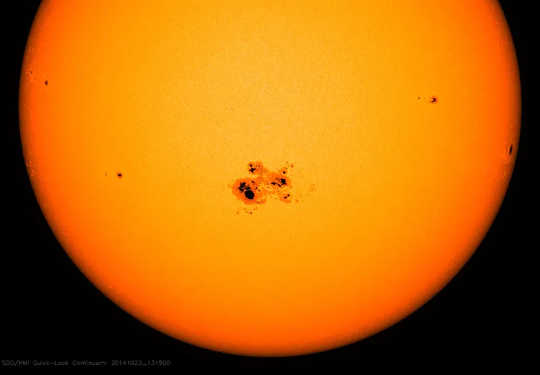Are we headed for a period with lower Solar activity, i.e. sunspots? How long will it last? What happens to our world when global warming and the end of this period converge?
When climate change comes up in conversation, the question of a possible link with the Sun is often raised.
The Sun is a highly active and complicated body. Its behaviour does change over time and this can affect our climate. But these impacts are much smaller than those caused by our burning of fossil fuels and, crucially, they do not build up over time.
The main change in the Sun is an 11-year Solar cycle of high and low activity, which initially revealed itself in a count of sunspots.
One decade of solar activity in one hour.
{vembed Y=3QQQu7QLoM}
Sunspots have been observed continuously since 1609, although their cyclical variation was not noticed until much later. At the peak of the cycle, about 0.1% more Solar energy reaches the Earth, which can increase global average temperatures by 0.05-0.1?.
This is small, but it can be detected in the climate record.
It’s smaller than other known sources of temperature variation, such as volcanoes (for example, the large eruption of Mt Pinatubo, in the Philippines in 1991, cooled Earth by up to 0.4? for several years) and the El Niño Southern Oscillation, which causes variations of up to 0.4?.
And it’s small compared to human-induced global warming, which has been accumulating at 0.2? per decade since 1980.
Although each 11-year Solar cycle is different, and the processes underlying them are not fully understood, overall the cycle has been stable for hundreds of millions of years.
A little ice age
A famous period of low Solar activity, known as the Maunder Minimum, ran from 1645 to 1715. It happened at a similar time as the Little Ice Age in Europe.
But the fall in Solar activity was too small to account for the temperature drop, which has since been attributed to volcanic eruptions.
Solar activity picked up during the 20th century, reaching a peak in the cycle that ran from 1954 to 1964, before falling away to a very weak cycle in 2009-19.
Bear in mind, though, that the climatic difference between a strong and a weak cycle is small.
Forecasting the Solar cycle
Because changes in Solar activity are important to spacecraft and to radio communications, there is a Solar Cycle Prediction Panel who meet to pool the available evidence.
Experts there are currently predicting the next cycle, which will run to 2030, will be similar to the last one. Beyond that, they’re not saying.
If activity picks up again, and its peak happened to coincide with a strong El Niño, we could see a boost in temperatures of 0.3? for a year or two. That would be similar to what happened during the El Niño of 2016, which featured record air and sea temperatures, wildfires, rainfall events and bleaching of the Great Barrier Reef.
The extreme weather events of that year provided a glimpse into the future. They gave examples of what even average years will look like after another decade of steadily worsening global warming.
A journey to the Sun
Solar physics is an active area of research. Apart from its importance to us, the Sun is a playground for the high-energy physics of plasmas governed by powerful magnetic, nuclear and fluid-dynamical forces.
The Solar cycle is driven by a dynamo coupling kinetic, magnetic and electrical energy.
That’s pretty hard to study in the lab, so research proceeds by a combination of observation, mathematical analysis and computer simulation.
Two spacecraft are currently directly observing the Sun: NASA’s Parker Solar Probe (which will eventually approach to just 5% of the Earth-Sun distance), and ESA’s Solar Orbiter, which is en route to observe the Sun’s poles.
Hopefully one day we will have a better picture of the processes involved in sunspots and the Solar cycle.![]()
Exploring the 11-year Solar cycle.
{vembed Y=zr1NKvIi8AU}
About the Author
Robert McLachlan, Professor in Applied Mathematics, Massey University
This article is republished from The Conversation under a Creative Commons license. Read the original article.
Related Books
Life After Carbon: The Next Global Transformation of Cities
by Peter Plastrik , John Cleveland The future of our cities is not what it used to be. The modern-city model that took hold globally in the twentieth century has outlived its usefulness. It cannot solve the problems it helped to create—especially global warming. Fortunately, a new model for urban development is emerging in cities to aggressively tackle the realities of climate change. It transforms the way cities design and use physical space, generate economic wealth, consume and dispose of resources, exploit and sustain the natural ecosystems, and prepare for the future. Available On Amazon
The future of our cities is not what it used to be. The modern-city model that took hold globally in the twentieth century has outlived its usefulness. It cannot solve the problems it helped to create—especially global warming. Fortunately, a new model for urban development is emerging in cities to aggressively tackle the realities of climate change. It transforms the way cities design and use physical space, generate economic wealth, consume and dispose of resources, exploit and sustain the natural ecosystems, and prepare for the future. Available On Amazon
The Sixth Extinction: An Unnatural History
by Elizabeth Kolbert Over the last half-billion years, there have been Five mass extinctions, when the diversity of life on earth suddenly and dramatically contracted. Scientists around the world are currently monitoring the sixth extinction, predicted to be the most devastating extinction event since the asteroid impact that wiped out the dinosaurs. This time around, the cataclysm is us. In prose that is at once frank, entertaining, and deeply informed, New Yorker writer Elizabeth Kolbert tells us why and how human beings have altered life on the planet in a way no species has before. Interweaving research in half a dozen disciplines, descriptions of the fascinating species that have already been lost, and the history of extinction as a concept, Kolbert provides a moving and comprehensive account of the disappearances occurring before our very eyes. She shows that the sixth extinction is likely to be mankind's most lasting legacy, compelling us to rethink the fundamental question of what it means to be human. Available On Amazon
Over the last half-billion years, there have been Five mass extinctions, when the diversity of life on earth suddenly and dramatically contracted. Scientists around the world are currently monitoring the sixth extinction, predicted to be the most devastating extinction event since the asteroid impact that wiped out the dinosaurs. This time around, the cataclysm is us. In prose that is at once frank, entertaining, and deeply informed, New Yorker writer Elizabeth Kolbert tells us why and how human beings have altered life on the planet in a way no species has before. Interweaving research in half a dozen disciplines, descriptions of the fascinating species that have already been lost, and the history of extinction as a concept, Kolbert provides a moving and comprehensive account of the disappearances occurring before our very eyes. She shows that the sixth extinction is likely to be mankind's most lasting legacy, compelling us to rethink the fundamental question of what it means to be human. Available On Amazon
Climate Wars: The Fight for Survival as the World Overheats
by Gwynne Dyer Waves of climate refugees. Dozens of failed states. All-out war. From one of the world’s great geopolitical analysts comes a terrifying glimpse of the strategic realities of the near future, when climate change drives the world’s powers towards the cut-throat politics of survival. Prescient and unflinching, Climate Wars will be one of the most important books of the coming years. Read it and find out what we’re heading for. Available On Amazon
Waves of climate refugees. Dozens of failed states. All-out war. From one of the world’s great geopolitical analysts comes a terrifying glimpse of the strategic realities of the near future, when climate change drives the world’s powers towards the cut-throat politics of survival. Prescient and unflinching, Climate Wars will be one of the most important books of the coming years. Read it and find out what we’re heading for. Available On Amazon
From The Publisher:
Purchases on Amazon go to defray the cost of bringing you InnerSelf.comelf.com, MightyNatural.com, and ClimateImpactNews.com at no cost and without advertisers that track your browsing habits. Even if you click on a link but don't buy these selected products, anything else you buy in that same visit on Amazon pays us a small commission. There is no additional cost to you, so please contribute to the effort. You can also use this link to use to Amazon at any time so you can help support our efforts.


























